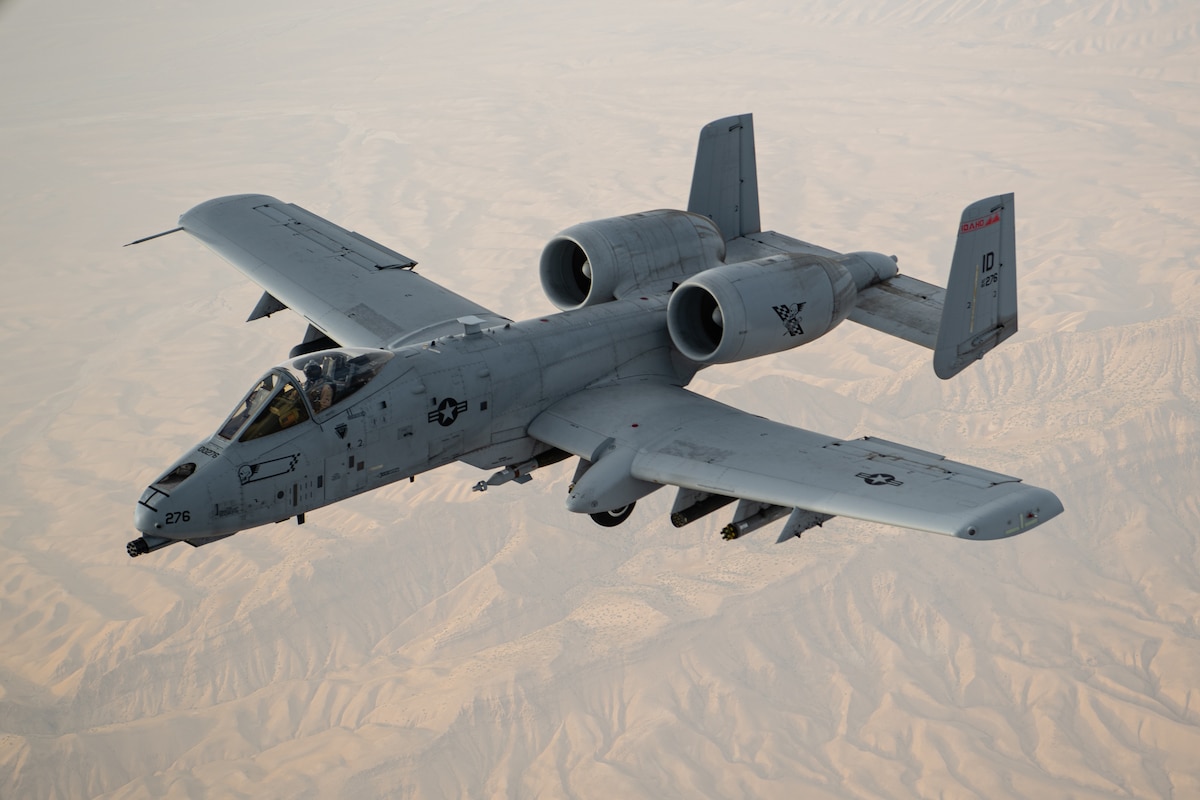MissionThe A-10C Thunderbolt II is the first Air Force aircraft specially designed for close air support of ground forces. They are simple, effective and survivable twin-engine jet aircraft that can be used against light maritime attack aircraft and all ground targets, including tanks and other armored vehicles.

FeaturesThe A-10C offers excellent maneuverability at low airspeeds and altitude while maintaining a highly accurate weapons-delivery platform. They can loiter near battle areas for extended periods of time, are capable of austere landings and operate under 1,000-foot ceilings (303.3 meters) with 1.5-mile (2.4 kilometers) visibility. Additionally, with the capability of carrying precision guided munitions and unguided munitions, they can employ above, below and in the weather. Their wide combat radius and short takeoff and landing capability permit operations in and out of locations near front lines. Using night vision goggles, A-10C pilots can conduct their missions during darkness.
Thunderbolt IIs have Night Vision Imaging Systems (NVIS), goggle compatible single-seat cockpits forward of their wings, Helmet Mounted Cueing Systems, and a large bubble canopy which provides pilots all-around vision. The pilots are protected by titanium armor that also protects parts of the flight-control system. The redundant primary structural sections allow the aircraft to enjoy better survivability during close air support than previous aircraft.
The aircraft can survive direct hits from armor-piercing and high explosive projectiles up to 23mm. Their self-sealing fuel cells are protected by internal and external foam. Manual systems back up their redundant hydraulic flight-control systems. This permits pilots to fly and land when hydraulic power is lost.

An A-10 Thunderbolt II assigned to Selfridge Air National Guard Base, Mich., prepares to land on a public highway in Alpena, Mich., Aug. 5, 2021. The highway landing was a part of exercise Northern Strike 21-2, a multi-component, multinational exercise hosted by the Michigan National Guard designed to build readiness and enhance interoperability with coalition forces to fight and win. (U.S. Air National Guard photo by Master Sgt. Scott Thompson)

U.S. Air Force Maj. Cody “ShIV” Wilton, the A-10 Warthog Demonstration Team commander and pilot, releases flares at the 2020 Fort Lauderdale Air Show Nov. 21, 2020, Fort Lauderdale, Florida. This airshow was Maj. Wilton’s last public demonstration performance of his career in the U.S. Air Force. (U.S. Air Force photo by Capt. Kip Sumner)

A U.S. Air Force A-10 Thunderbolt II flies over the U.S. Central Command area of responsibility in support of Operation Freedom’s Sentinel, June 29, 2020. The Thunderbolt II is a highly accurate, global reach airframe that provides U.S. and coalition forces a maneuverable close air support and precision strike platform. (U.S. Air Force photo by Staff Sgt. Justin Parsons)
The Thunderbolt II can be serviced and operated from bases with limited facilities near battle areas. Many of the aircraft’s parts are interchangeable left and right, including the engines, main landing gear and vertical stabilizers.
Avionics equipment includes communications, inertial navigation and GPS, fire control and weapons delivery systems, target penetration aids and night vision goggles. Their weapons delivery systems include heads-up displays that indicate airspeed, altitude, dive angle, navigation information and weapons aiming references; and a low altitude safety and targeting enhancement system (LASTE) which provides constantly computing impact point freefall ordnance delivery. The aircraft also have armament control panels, and infrared and electronic countermeasures to handle surface-to-air-threats, both missile and anti-aircraft artillery.
The Thunderbolt II’s 30mm GAU-8/A Gatling gun can fire 3,900 rounds a minute and can defeat an array of ground targets to include tanks. Some of their other equipment include electronic countermeasures, target penetration aids, self-protection systems and an array of air-to-surface weapons, including laser and GPS guided munitions, AGM-65 Maverick and AIM-9 Sidewinder missiles.
BackgroundThe first production A-10A was delivered to Davis-Monthan Air Force Base, Arizona, in October 1975. It was designed specifically for the close air support mission and had the ability to combine large military loads, long loiter and wide combat radius, which proved to be vital assets to the United States and its allies during Operation Desert Storm and Operation Noble Anvil.

General CharacteristicsPrimary Function: A-10 — close air support, airborne forward air control, combat search and rescueContractor: Fairchild Republic Co.Power Plant: Two General Electric TF34-GE-100 turbofansThrust: 9,065 pounds each engineLength: 53 feet, 4 inches (16.16 meters)Height: 14 feet, 8 inches (4.42 meters)Wingspan: 57 feet, 6 inches (17.42 meters)Speed: 420 miles per hour (Mach 0.56)Ceiling: 45,000 feet (13,636 meters)Maximum Takeoff Weight: 51,000 pounds (22,950 kilograms)Range: 800 miles (695 nautical miles)Armament: One 30mm GAU-8/A seven-barrel Gatling gun; up to 16,000 pounds (7,200 kilograms) of mixed ordnance on eight under-wing and three under-fuselage pylon stations, including 500 pound (225 kilograms) Mk-82 and 2,000 pounds (900 kilograms) Mk-84 series low/high drag bombs, incendiary cluster bombs, combined effects munitions, mine dispensing munitions, AGM-65 Maverick missiles, laser-/GPS-guided bombs, unguided and laser-guided 2.75-inch (6.99 centimeters) rockets; infrared countermeasure flares; electronic countermeasure chaff; jammer pods; illumination flares and AIM-9 Sidewinder missiles.Crew: OneDate Deployed: March 1976Unit Cost: $9.8 million (fiscal 98 constant dollars)Inventory: Total Force – approximately 281





